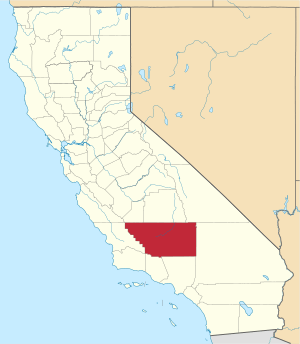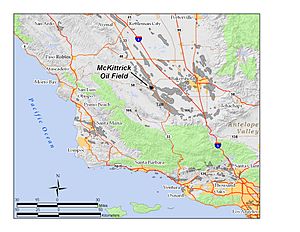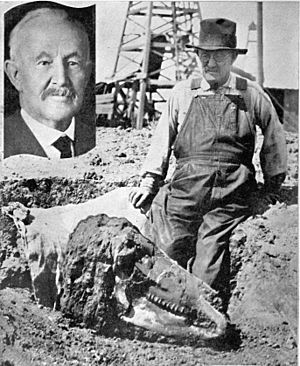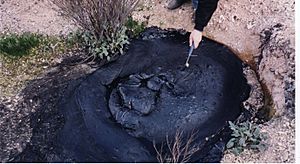McKittrick Tar Pits facts for kids
Quick facts for kids McKittrick Tar Pits |
|
|---|---|
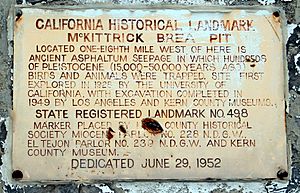
McKittrick Tar Pits sign
|
|
| Location | State Hwy 33 (P.M. 33. 5) and State Hwy 58, in McKittrick, California |
| Official name: McKittrick Tar Pits | |
| Designated | February 4, 1951 |
| Reference no. | 498 |
The McKittrick Tar Pits are natural lakes made of asphalt. They are also called McKittrick Oil Seeps or McKittrick Brea Pits. You can find them in the western part of Kern County, in southern California. These pits are the largest natural asphalt lakes in California.
The McKittrick Tar Pits are one of only five natural asphalt lake areas in the whole world. The others are Tierra de Brea in Trinidad and Tobago, Lake Guanoco in Venezuela, and the La Brea Tar Pits (in Los Angeles) and Carpinteria Tar Pits (in Carpinteria), both also in California. These pits have trapped and preserved hundreds of ancient animals.
Where are the McKittrick Tar Pits?
The McKittrick Tar Pits are located in the southern part of the San Joaquin Valley. They are about 50 kilometers (30 miles) west of Bakersfield. They are also about 0.8 kilometers (0.5 miles) south of the small town of McKittrick.
Most of the tar pits are found near where California State Route 58 and 33 meet. The tar comes from the McKittrick Oil Field underneath the ground. These pits stretch for about 6.5 kilometers (4 miles).
How Tar Pits Formed
The asphalt lakes in the McKittrick area likely formed during the Pleistocene Ice Age. They were created in a similar way to other natural asphalt lakes around the world.
The creation of an asphalt lake starts with deep cracks in the Earth, called faults. These faults are often found where two tectonic plates meet. When these plates move, they create pressure on oil deep underground. This oil comes from a rock layer called the Monterey Formation.
The oil then slowly moves up towards the surface. As it travels, it changes into a thick, sticky substance called bitumen. It also picks up clay and water along the way. When it reaches the surface, it cools and becomes asphalt. The lighter parts of the oil evaporate into the air. This leaves behind the heavier, sticky asphalt.
History and Discoveries
No one knows exactly when the McKittrick Tar Pits were first found. The local Native American Yokut people knew about them for a very long time. They would dig up the asphalt and use it for many things. They used it to make things waterproof, for decoration, and even for trading with other groups.
In the 1860s, settlers in the San Joaquin Valley also started to dig up the tar. They used both open pits and shafts to get it. The first time the tar was dug up for business was by a group called the "Buena Vista Petroleum Company."
The tar pits have been very important for science. They have trapped and kept safe hundreds of animals from the Pleistocene Age. The first studies of these ancient animals happened between 1900 and 1910. In 1928, a big team of scientists from the University of California started major excavations. More work was done in 1949 by teams from the Natural History Museum of Los Angeles County and the Kern County Museum. By 1968, scientists had found more than 43 different kinds of mammals and 58 different kinds of birds in the pits.
On June 29, 1952, the McKittrick Tar Pits were officially named a California Historical Landmark.
The California Historical Landmark sign says:
- NO. 498 MCKITTRICK BREA PIT - Located one-eighth mile west of here is an ancient asphaltum seepage in which hundreds of Pleistocene Age (15,000-50,000 years ago) birds and animals were trapped. The site was first explored in 1928 by the University of California - excavation was completed in 1949 by the Los Angeles and Kern County museums.
See also
 In Spanish: Pozos de brea de McKittrick para niños
In Spanish: Pozos de brea de McKittrick para niños


